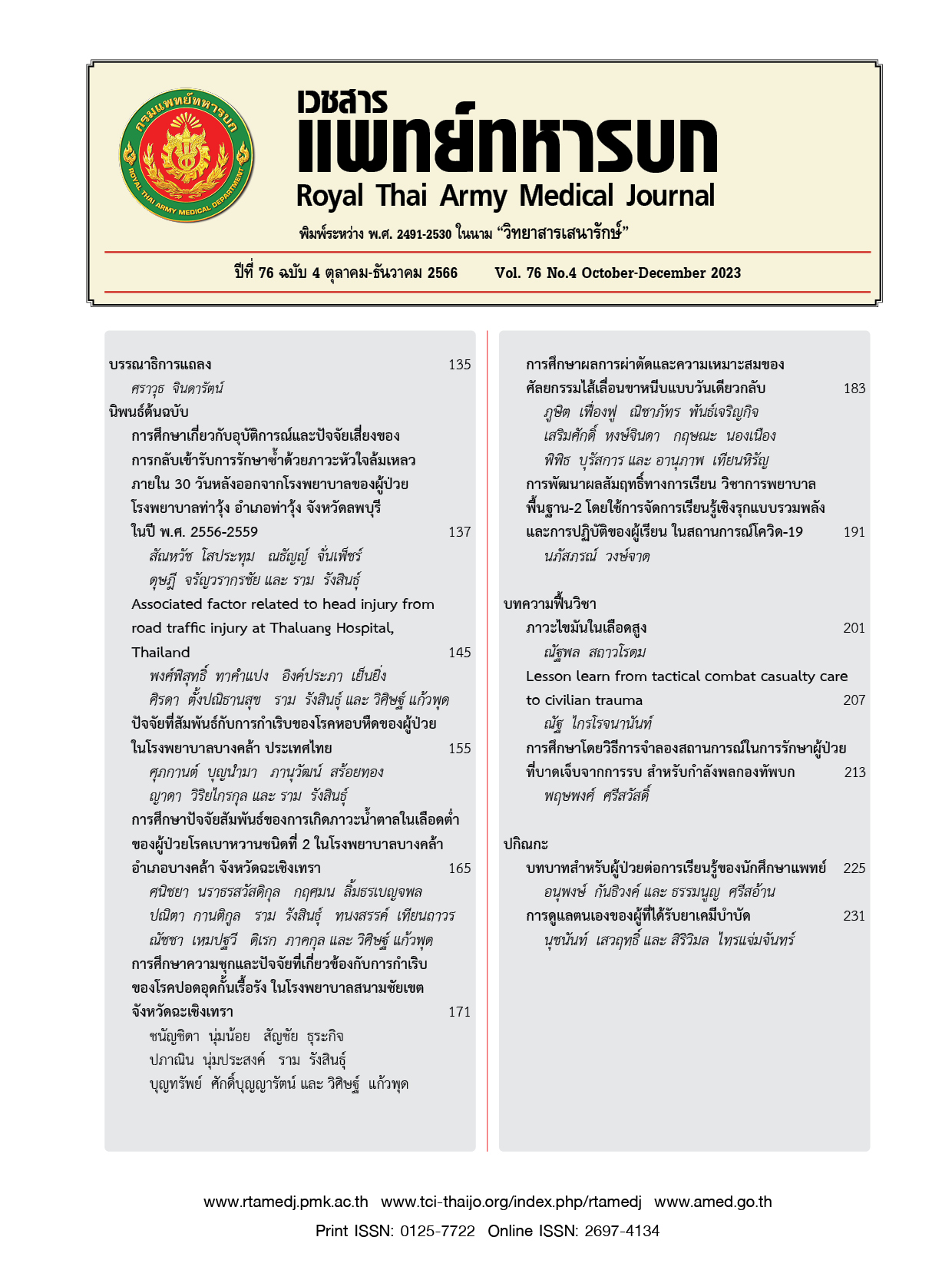การศึกษาความชุกและปัจจัยที่เกี่ยวข้องกับการกําเริบของโรคปอดอุดกั้นเรื้อรัง ในโรงพยาบาลสนามชัยเขต จังหวัดฉะเชิงเทรา
Main Article Content
บทคัดย่อ
ที่มาและความสำคัญ การกำเริบของโรคปอดอุดกั้นเรื้อรังเป็นปัญหาสำคัญที่ส่งผลกระทบทางร่างกาย เศรษฐกิจ และสังคม ปัจจุบันยังมีการศึกษาวิจัยปัจจัยเสี่ยงและความชุกของการกำเริบของโรคปอดอุดกั้นเรื้อรัง ยังมีน้อยในชุมชนชนบทในประเทศไทยดังนั้นผู้วิจัย จึงมีความสนใจในเรื่องนี้ วิธีการดำเนินการวิจัย งานวิจัยนี้เป็นงานวิจัยแบบ cross-sectional study ซึ่งศึกษาในผู้ป่วยโรคปอดอุดกั้นเรื้อรังในโรงพยาบาลสนามชัยเขตจังหวัดฉะเชิงเทรา ในระหว่างวันที่ 3-28 กันยายน 2561 โดยทำการสํารวจประชากรที่วินิจฉัยว่าเป็นโรคปอดอุดกั้นเรื้อรัง ตั้งแต่วันที่ 1 กันยายน 2560 ถึง 1 กันยายน 2561 ข้อมูลเรื่อง เพศ อายุ ดัชนีมวลกาย อาชีพที่สัมผัสกับควันแก๊สเชื้อเพลิง สถานะการสูบบุหรี่ (ไม่เคยสูบบุหรี่ ยังสูบบุหรี่อยู่ และไม่เคยสูบบุหรี่) การได้รับควันบุหรี่ทางอ้อม ฤดูกาล ความรุนแรงของการอุดกั้นหลอดลม การติดเชื้อของระบบทางเดินหายใจ ยาของโรคปอดอุดกั้นเรื้อรัง วิธีการใช้ยาพ่น การใช้ยาไม่สม่ำเสมอ การได้รับวัคซีนไข้หวัดใหญ่ การติดตามการรักษาถูกเก็บรวบรวม จากข้อมูลของคนไข้และนํามาวิเคราะห์ข้อมูล ผลการศึกษา ผู้เข้าร่วมวิจัยทั้งสิ้น 150 คน ตามเกณฑ์ในการคัดเข้าและแยกออกของผู้เข้าร่วมวิจัย โดยส่วนใหญ่เป็นผู้ชาย (79%), อายุเฉลี่ย 66.29 ปี (SD = 9.422) ความชุกของการกำเริบของโรคปอดอุดกั้นเรื้อรัง ร้อยละ 47.3 ด้วยความถี่มากที่สุดในเดือนมกราคม 30 ครั้ง (14.29%) multivariable analysis ปัจจัยที่สัมพันธ์กับการเกิดการกำเริบของโรคปอดอุดกั้นเรื้อรัง คือโรคปอดอักเสบ (OR 4.605, 95%CI: 1.439-14.440, p-value = 0.010) การไม่ฉีดวัคซีนไข้หวัดใหญ่ (OR 0.347, 95%CI: 0.168-0.715, p-value = 0.004) การใช้ยาแบบ triple therapy (OR 1.962, 95%CI: 1.004-3.883, p-value = 0.048) การใช้ยาพ่นถูกวิธี (OR 0.301, 95%CI: 0.154- 0.589, p-value < 0.001) และการไม่มาติดตามการรักษาตามนัด (OR 21.591, 95%CI: 7.125-65.426, p-value < 0.001) สรุป ความชุกของการกำเริบของโรคปอดอุดกั้นเรื้อรัง ร้อยละ 47.3 ซึ่งมากกว่าความชุกของการกำเริบในประเทศไทย โดยพบห้าปัจจัยที่มีผลกับการกำเริบของโรคปอดอุดกั้นเรื้อรัง คือ วิธีการใช้ยาพ่น การใช้ยาไม่สม่ำเสมอ การขาดนัดการรักษาซึ่งสามารถแก้ไขได้ โรคปอดอักเสบควรมีมาตรการป้องกัน และการใช้ยาสามชนิด (LABA และ ICS plus LAAC) ควรมีการทำการศึกษาเพิ่มเติมต่อไป
Downloads
Article Details

อนุญาตภายใต้เงื่อนไข Creative Commons Attribution-NonCommercial-NoDerivatives 4.0 International License.
บทความในวารสารนี้อยู่ภายใต้ลิขสิทธิ์ของ กรมแพทย์ทหารบก และเผยแพร่ภายใต้สัญญาอนุญาต Creative Commons Attribution-NonCommercial-NoDerivatives 4.0 International (CC BY-NC-ND 4.0)
ท่านสามารถอ่านและใช้งานเพื่อวัตถุประสงค์ทางการศึกษา และทางวิชาการ เช่น การสอน การวิจัย หรือการอ้างอิง โดยต้องให้เครดิตอย่างเหมาะสมแก่ผู้เขียนและวารสาร
ห้ามใช้หรือแก้ไขบทความโดยไม่ได้รับอนุญาต
ข้อความที่ปรากฏในบทความเป็นความคิดเห็นของผู้เขียนเท่านั้น
ผู้เขียนเป็นผู้รับผิดชอบต่อเนื้อหาและความถูกต้องของบทความของตนอย่างเต็มที่
การนำบทความไปเผยแพร่ซ้ำในรูปแบบสาธารณะอื่นใด ต้องได้รับอนุญาตจากวารสาร
เอกสารอ้างอิง
World Health Organization. Fact sheet: Burden of Chronic obstructive pulmonary disease [Internet]. [updated 1 Dec 2017; cited 8 Sep 2018]. Available from: http://www.who.int/respiratory/copd/burden/en
Bousquet J, Khaltaev N. Global surveillance, prevention and control of chronic respiratory diseases, A comprehensive approach. Switzerland: World Health Organization; 2007.
Lozano R, Naghavi M, Foreman K, Lim S, Shibuya K, Aboyans V, et al. Global and regional mortality from 235 causes of death for 20 age groups in 1990 and 2010: a systematic analysis for the Global Burden of Disease Study 2010. Lancet. 2012;380(9859):2095-128.
Mathers CD, Loncar D. Projections of global mortality and burden of disease from 2002 to 2030. PLoS Med. 2006;3(11):e442.
Lim S, Lam DC, Muttalif AR, Yunus F, Wongtim S, Lan le TT, et al. Impact of chronic obstructive pulmonary disease (COPD) in the Asia-Pacific region: the EPIC Asia population-based survey. Asia Pac Fam Med. 2015;14(1):4.
Global Initiative for Chronic Obstructive Pulmonary Disease (GOLD). Global Strategy for the Diagnosis, Management and Prevention of COPD [Internet]. 2018 [cited 8 Sep 2018]. Available from: https://goldcopd.org/
Kuwalairat P, Ratanaopas S, Sornkate R. Prevalence of chronic obstructive pulmonary diseases related-hospitalization with acute exacerbation and its associated factors in Thailand. Eur Respir J. 2017;50:PA930.
Anzueto A. Impact of exacerbations on COPD. Eur Respir Rev. 2010;19(116):113-8.
Borrell E, Rodríguez M, Torán P, Muñoz L, Pera G, Montellà N, et al. Incidence and risk factors of exacerbations among COPD patients in primary health care: APMPOC study. BMC Public Health. 2009;9:8.
Ramsey SD, Hobbs FD. Chronic obstructive pulmonary disease, risk factors, and outcome trials: comparisons with cardiovascular disease. Proc Am Thorac Soc. 2006;3(7):635-40.
Ko FW, Hui DS. Air pollution and chronic obstructive pulmonary disease. Respirology. 2012;17(3):395-401.
Müllerová H, Shukla A, Hawkins A, Quint J. Risk factors for acute exacerbations of COPD in a primary care population: a retrospective observational cohort study. BMJ Open. 2014;4(12):e006171.
Wei X, Ma Z, Yu N, Ren J, Jin C, Mi J, et al. Risk factors predict frequent hospitalization in patients with acute exacerbation of COPD. Int J Chron Obstruct Pulmon Dis. 2017;13:121-9.
Viniol C, Vogelmeier CF. Exacerbations of COPD. Eur Respir Rev. 2018;27(147):170103.
Duangrithi D, Saiprom K, Tew JS, Sa-u Y. Impact of exacerbation on the errors of inhaler techniques in COPD patients. J App Pharm Sci. 2017;7(5):84-9.
Pothirat C, Pothirat T, Liwsrisakun C, Bumroongkit C, Deesomchok A, Theerakittikul T, et al. Risk Factors of Severe Acute Exacerbation of Chronic Obstructive Pulmonary Disease Among Patients Regularly Managed by Pulmonologists. J Med Assoc Thai. 2017; 100(2):142-8.
Jenkins CR, Celli B, Anderson JA, Ferguson GT, Jones PW, Vestbo J, et al. Seasonality and determinants of moderate and severe COPD exacerbations in the TORCH study. Eur Respir J. 2012;39(1):38-45.


